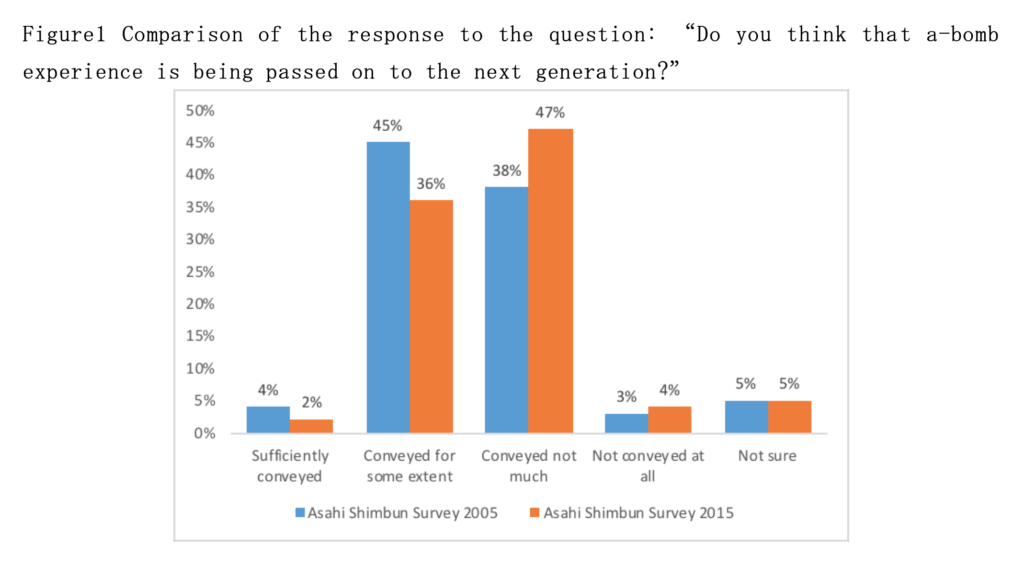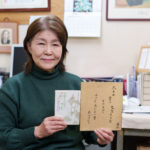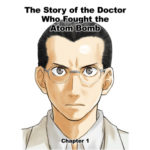II Difficulty in Inheriting A-bomb Experience
As will be described later, although various projects for inheriting a-bomb experience have been conducted, there are difficulties in the task. The most difficult point is that, to speak frankly, the next generations who inherit the a-bomb experience are not a-bomb survivors and do not have a-bomb experiences. It is impossible for us to understand the actual situation of the atomic bombing in the same way as a-bomb survivors see it. In other words, there is something to be lost in the inheritance process. Therefore, regarding the inheritance of the a-bomb experience, how to resist this loss is key.
Incidentally, how do a-bomb survivors think about inheritance? Figure 1 shows the response to the question “Do you think the a-bomb experience is being transmitted to the next generation?” in the surveys concerning a-bomb experience inheritance conducted by the Asahi Shimbun in 2005 and 2015. 6) In the 2005 survey, nearly half were answered that the experience is being transmitted, however, in the same survey conducted 10 years later, more than half of the respondents answered that it is not being transmitted, showing a reversal of the opinion. This indicates that about half of the a-bomb survivors feel that the a-bomb experience is not being passed on to the next generations so much, and also shows that they feel that the inheritance does not proceed as expected.

In addition, in a survey with a similar question carried out jointly by the Yomiuri Shimbun with the Institute for Peace Science, Hiroshima University, to which the author belongs 7), 13% responded “Yes,” 51% responded “No,” and 31% responded “Not sure” to the question “Is the a-bomb experience being fully inherited?” In the same survey in 2010, 61% responded “Yes” to the question “Do you think the a-bomb experience is being inherited?” Concerning these results, it can be said that many a-bomb survivors feel that their experience is not being inherited as expected. It is clear that the survivors feel that they have not yet conveyed their entire experience. In addition, there are feelings such as “It is tough,” “I do not want to recall,” and “I do not think it is understood.” In the survey by the Asahi Shimbun in 2015, 20% answered “I cannot remember clearly,” 21% said “I do not want to recall because it is painful,” 19% said “I do not think the a-bomb experience is understood,” 20% said “There is no opportunity to talk about it.” 14% answered “I fear discrimination and prejudice” to the question “Why have you not spoken about the a-bomb experience?” Also, to the question “Why did you not convey your experience to your children?” in the survey conducted by the Yomiuri Shimbun in 2015, 55% said “I have not yet been asked.” 39% said “I do not want to recall because it is painful,” 38% answered “I live apart from my child (or children) and have less opportunity to talk about it,” 38% responded “I do not think the experience is understood.”
Thus, for the a-bomb survivors who are responsible for conveying their experience, it is a painful and dreadful memory, and there is a feeling that it is hard for people who did not experience it to understand. Because it is an experience which is frequently called “beyond description” or “hell,” it is hard to talk about and transmit. These survey results indicate how serious and traumatic the harm caused by the bomb was.
Though they have thoughts they believe they must convey, a-bomb survivors have complicated feelings which deter them. However, the a-bomb survivors continue their efforts. This is a relatively old date, but 21 groups that handle a-bomb experience testimony projects in Hiroshima had conducted 51,635 testimony projects during the 25 years from 1987 to 2011. 9) Ube (1999: 390) confirmed 3,542 magazines where “A-bomb Notes” appeared in the 50 years after the war’s end, and also pointed out that 37,793 notes were recorded in these magazines. The atomic bombing is certainly talked about and conveyed.
At the same time, many of the a-bomb survivors aspire to “a nuclear-free world” and a-bomb organizations make “a nuclear-free world” a central part of their cause. In addition to advocacy, they continue to communicate the message “a nuclear-free world.” Why? That may be associated with the fact that many a-bomb survivors believe a third atomic bomb was not dropped because of the dreadful experiences of Hiroshima and Nagasaki. To the question “Do you think that nuclear weapons were not used after Hiroshima and Nagasaki because their experiences were conveyed to the world?” in the survey by the Asahi Shimbun in 2010, 66% responded “I agree.” In the same survey, there was a question “Do you think that handing down the a-bomb experience deters the use of nuclear weapons?” To this question, 76% responded “I agree.” In other words, most a-bomb survivors believe that communicating their experience and their existence to the world contributes to the avoidance of the use of nuclear weapons. 11)
6) The 2005 survey was conducted jointly by the Asahi Shimbun, Hiroshima University and Nagasaki University. The number of respondents was 13,204. For details of the results, please refer to the morning edition of July 17, 2005. The number of respondents to the 2015 survey was 5,762. For details, please refer to the morning edition of August 2, 2015. Incidentally, the authors have written a number of papers citing the 2005 survey results. Please see profile of Noriyuki Kawano on Hiroshima University’s website.
7) The number of respondents was 1,943. For details of the research, please refer to the morning edition of July 29, 2015.
8) Jointly conducted with the Hiroshima Reconstruction and Peacebuilding Research Project. The number of respondents was 1,015. For details, please refer to the morning edition of July 30, 2010.
9) Based on a summary by the Hiroshima Peace Culture Foundation. According to this, a total of 5,772,121 people participated in testimony events. However, the actual number of testimonies is 228, and it is assumed that a limited number of witnesses are engaged in testimony activities. Incidentally, the Hiroshima Peace Culture Foundation is included in 21 groups.
10) The number of respondents was 1,006. For details, please see the morning edition of July 29, 2010.
11) For details, please see Kawamoto (2016).
Tags associated with this article






